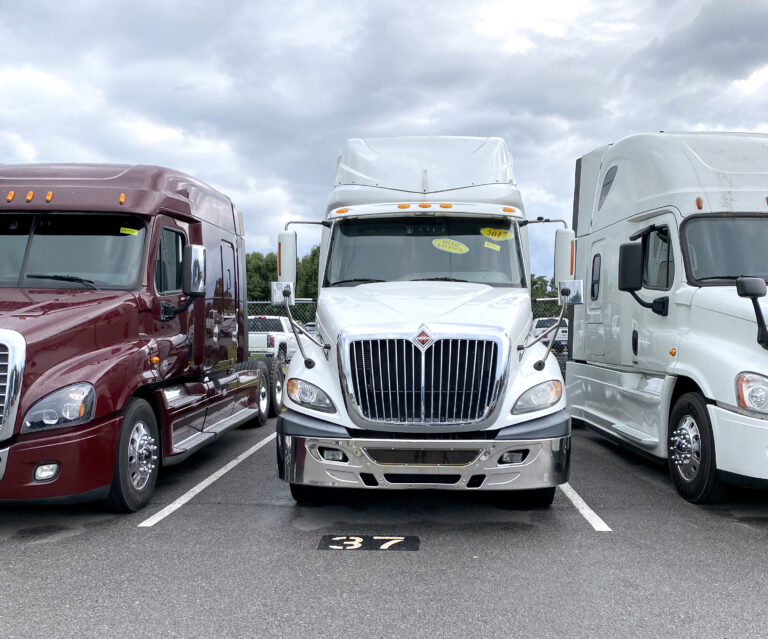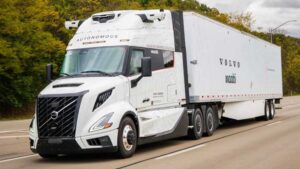May sales of new Class 8 trucks on the U.S. market increased by 7.6% in May over April sales figures, according to data received from ACT Research. Sales of 21,272 units made May the best month of the year so far — and the best May since 2019. May was also the first month when sales exceeded those in the corresponding month in 2021, when 18,761 trucks were sold.
So, how did OEMs sell more than 21,000 trucks in a month when just 19,500 were built?
“We’ve been seeing inventory building and you wonder, with demand so strong, why is inventory continuing to grow?” said Kenny Vieth, president and senior analyst at ACT Research.
Part of the answer is that many trucks were nearly completed in previous months and then parked at the factory or the dealer, waiting for a final part or two to come in before delivery to the customer.
“It shows maybe some parts finally made it to the supply chain,” Vieth added.
Of the new Class 8 trucks sold, 16,402 (77.1%) were fifth-wheel equipped over-the-road tractors, while the remainder were vocational models with dump, concrete, trash or other bodies mounted.
Freightliner led the charge, reporting sales of 7,309, according to data received from Wards Intelligence. Compared to April’s 6,653, Freightliner sales increased 6.9%.
The biggest growth of sales by percentage, however, went to International, which reported sales of 2,799 — an increase of 46.5% over April’s 1,911.
Kenworth’s 2,803 units sold topped April’s 2,588 by 8.3% but lagged behind May 2021 sales of 2,919 by 4%. PACCAR sibling Peterbilt reported sales of 3,375 trucks in May, a 6.4% climb from 3,173 sold in April and 15.1% better than the 2,933 sold in May 2021.
Volvo reported sales of 2,546, topping April sales by 121 trucks for an increase of 5%. Compared with May 2021, when 1,413 Volvos were sold, sales increased by a whopping 80.2%. Volvo-owned Mack Truck reported sales of 1,372, a decline of 5.2% from April’s 1,448 trucks sold.
Western Star, a Freightliner company, sold 511 units in May, down 23.7% from April’s 670. Still, sales bested the 447 sold in May 2021 by 14.3%.
Truck manufacturers have been hampered for more than a year by supply chain issues. Semiconductors are in short supply, and components needed to build trucks have been delayed by COVID closings. Materials such as steel and aluminum have been hard to come by and expensive when available.
To counter supply chain issues, OEMs are taking some unusual steps. Some are building trucks that are parked on the lot, waiting for a final component to arrive. Once the parts are available, they can quickly be installed and the trucks moved out.
Another tactic is to simply sell trucks without some of the options. Trucks have been delivered to carriers without window actuators, ADAS features such as adaptive cruise control, and even without passenger seats.
Orders for new trucks have far outstripped production, resulting in wait times of a year or longer for delivery.
FTR reported that new truck orders are dropping to levels far below last year’s pace, but part of the reason is that OEMs are reluctant to book orders so far in the future.
“The supply chain was making slight improvements in the last few months,” said Don Ake, vice president, commercial vehicles for FTR. “The OEMs are not confident they can increase production in the second half of the year; therefore, they are not able to take more orders.”
In the used truck market, prices have reached record levels. One reason is that some carriers turned to used trucks when they couldn’t get new trucks to expand their fleets. Another reason, judging from the record numbers of new carrier registrations granted by the DOT last year, is drivers buying trucks and starting their own companies to take advantage of surging spot freight rates.
The pendulum has swung the other way in the trucking industry as rising fuel costs and falling rates have made it more difficult for small trucking businesses to profit. Large numbers of them are closing their doors.
Avery Vise, vice president of trucking at FTR, addressed the issue in a June 6 podcast.
“Net revocations of for-hire authority approached 9,300 (in May) and were more than double the number recorded in April and were a record,” he said, pointing out that most revocations are made due to insurance lapses, which have a 30-day grace period.
“Most of the operations that had authority revoked in May probably already failed in March and in April. I’m sure that most of them probably stopped operating in that first two weeks after the surge in diesel prices,” Vise concluded.
A June 15 press release from ACT Research was entitled, “US Used Truck Sales Cycle at the Beginning of the End.” The release predicted that used truck prices have reached a peak and will soon begin coming down.
Unfortunately, rising fuel costs, falling freight rates and rising interest rates seem to conspire against a truck purchase. On June 15, the Federal Reserve raised its key interest rate by .75%, the largest increase since 1994. Fed chair Jay Powell said that a similar hike is possible at the Fed’s next meeting in July.
“By raising interest rates, the Fed is hitting the economy’s brakes to slow the economy down. So, that’s, going to add to the problem of declining freight,” explained Vieth.
Recession is very possible, Vieth said. At least, a freight recession. As consumers spend more of their dollars on fuel and food, less is left over to purchase goods that truckers haul as freight.
“Because the freight cycle has been growing for two years, and, is due for a rollover,” Vieth continued. “The roll off is occurring almost exactly when we thought it was going to. What’s different is the speed at which the roll off is occurring is much sharper than our forecasts were originally anticipating.”
Nobody knows how long the trucking downcycle will last, or how deep it will go, but for now, investing in new equipment remains an expensive proposition with little guarantee of profits in a tightening market.
Cliff Abbott is an experienced commercial vehicle driver and owner-operator who still holds a CDL in his home state of Alabama. In nearly 40 years in trucking, he’s been an instructor and trainer and has managed safety and recruiting operations for several carriers. Having never lost his love of the road, Cliff has written a book and hundreds of songs and has been writing for The Trucker for more than a decade.














